A good blanket gives you the perfect warm, fuzzy, and cuddly sensation to fall asleep instantly. However, not all blankets suit everyone.
So, you can’t mindlessly buy just any blanket and fall asleep like a baby. Moreover, they come in different sizes, materials, styles, and price ranges.
NOTE
We have enlisted our recommended blankets in this guide, here.
If you’re confused, let’s find your perfect snuggly blanky with this guide…
Types of Blankets
None of us use a blanket just in the bed. Sometimes we wrap it around us to enjoy a cup of coffee. If you sleep with someone, you might even have different needs for warmth.
Thus, based on different usages, a variety of blankets are available, including…
1. Standard Blanket
Standard blankets are available in varying sizes like twin, full, queen, and king. It’ll easily lay across your bed and hang over the sides enough to tug them under the bed.
These are available in all kinds of materials. You may either keep the bed just with the blanket or layer it under a duvet, comforter, or quilt.
2. Throw Blanket
The size of throw blankets is much smaller than standard blankets. These blankets are available in a variety of materials like cotton and fleece. It’s best suited at the foot of the bed for decoration purposes.
However, it’s also great for short naps and you don’t have the heart to undo your well-tugged standard blanket. These can also work like an extra layer of warmth on chilly nights.
3. Weighted Blanket
By the name, you can already guess that these blankets have added weights.
Many of you might ask “Do weighted blankets help you sleep?”
They absolutely do. If you feel snuggling and/or cuddling is comfortable, these blankets are just for you as they put extra pressure on your body. The added pressure feels like a sense of security of being held in bed which improves the quality of sleep.
However, the best-weighted sleep blankets for you depend on your personal needs. So, if you’re a hot sleeper, a regular weighted blanket might be too hot. You must check for weighted blankets with higher breathability and cool sleeping technology.
4. Electric Blanket
Electric blankets are made of synthetic materials used in housing electric heating elements. These blankets allow you to personalize the blanket temperature as per your comfort.
If you share a bed with someone, you can also look for dual-control electric blankets. These help you have different preferred temperatures on either side of your blanket.
However, make sure you don’t layer another blanket over an electric blanket and never keep these around kids for safety purposes.
5. Afghan Blanket
Many debate that an Afghan isn’t a blanket but there’s no specific reason behind it. Just like any regular blankets, Afghans keep you warm.
These blankets are usually made of crocheted or knitted wool, cotton, linen, and other natural fibers (the regular blanket materials). These are available in single pieces or mile-a-minute (separate strips knitted/sewn together).
You might also find motif Afghan blankets with granny squares or blocks. Due to the large variety, these blankets are warm and work as a statement decorative piece.
However, depending on the construction, it’s difficult to clean these. The safest way is hand washing followed by air drying. Or you can wash it on a delicate cycle for machine washing.
6. Car Blanket
These are a smaller variety of electric blankets but are mainly used for traveling purposes. You can plug them in a 12V outlet or cigarette lighter. These are generally available in fleece or polyester.
You can have added features on the high-end ones like a varied temperature setting, auto turn-off, indicator lights, and machine washing. However, most brands promote spot-washing for safety.
A quality car blanket can warm you like any regular blanket even if you don’t switch them on.
7. Chenille Blanket
Chenille blankets feel the softest out of all the available types due to their build. It can be made from cotton, acrylic, or rayon.
The fibers are tightly wrapped around a core which makes the fabric edges stand out at 90 degrees. This angular fiber wrapping leads to the unique softness in the final product.
Most of these are easily washable and cleanable, but some need dry cleaning depending on the materials.
However, chenille being one of the most attractive, comfortable, soft, and chic blankets is obviously expensive.
8. Emergency Blanket
Aka Mylar or Space blankets have reflective external surfaces, are lightweight, and aren’t bulky. It helps reduce body heat loss. Usually, campers and survivalists use these. The most common ones are made of thin metallic sheets folded into a very small and thin area.
Emergency blankets are also a common constituent in first aid kits. Since they can radiate all the heat and are huge, they can also be used as a heat-protective shelter. Due to the shiny metallic finish, it’s a great rescue signal too.
However, these are difficult to open if you’re injured and hard to use in windy conditions. Furthermore, they degrade over time if they’re not used for years.
Have you picked your preferred type of blanket? Think you’re all set to buy one? Well, not yet, because we have a lot more to consider…
What to consider before buying a blanket?
To find your perfect blanket, you must consider all the different factors like whether you’re allergic to any material or what kind of softness you desire, the size depending on your usage, your body temperature while sleeping, and the weaving. So, let’s choose what works the best for you here…
1. Size
If you want a blanket specifically for your bed, it must be large enough to cover your entire bed and hang a few inches from the sides and bottom to tuck them under your mattress for a smooth and elegant look.
Though the blanket size depends on the manufacturers and brands, the usual length and width sizes are:
Twin: 90” × 66”
Full: 90” × 85”
Queen: 90” × 100”
King: 100” × 110”
Depending on whether you like wrapping yourself in a blanket, like the blanket to lay over you, want it for solo or couple use, the size of your needed blanket will vary.
2. Fabric
Different blanket fabrics have different advantages so you might feel confused while choosing the suitable one for you. So, let’s find your best fit here…
a) Cotton
Pros
- Since cotton can take multiple washes without wear and tear, they’re easily cleanable, it’s a great hypoallergenic material.
- The different weaves make the fabric versatile. Lightweight cotton weave blankets make the best blanket for hot sleepers. Since cotton is a breathable material, it’s great for summer usage. Heavyweight cotton weave blankets make good winter blankets.
- If you follow a green lifestyle, you can also pick organic cotton.
Cons
- Cotton blankets become extremely heavy when wet and take long hours to dry.
- They aren’t safe for camping and hunting because they’re flammable.
Types
Flannel-cotton
This is usually a cotton-wool combination with other synthetic fibers. These blankets are usually knitted and hardly wrinkle.
Though they’re easily washable and durable, they shrink down if they’re dried with even mild heat. So, choose a lower cotton ratio flannel blanket to avoid shrinkage and wrinkling.
Satin-cotton
These blankets give you a smooth and luxurious feeling, but they always need dry cleaning and easily get damaged. Though satin is usually a silk product but not always. Satin cotton is a mixture of cotton and synthetic fibers like polyester. It’s a more affordable alternative that feels like silk.
Egyptian-cotton
These are the best quality cotton blankets. They’re breathable, moisture-absorbing, and highly durable. They don’t shrink like regular cotton.
However, they’re extremely expensive, so check for genuine products while buying one.
b) Wool
Pros
- This fabric makes your blanket heavy and warm with outstanding insulation. So, it’s great for campers, hunters, and survivalists.
- It’s fire-resistant.
- It also allows moisture to evaporate quickly.
- It’s biodegradable and environment-friendly.
- These blankets don’t need frequent washes due to their antibacterial nature.
- It’s water repellent and can protect you from light rain and mist.
Cons
- Quality wool blankets are expensive.
- They take a long time to dry if they get wet.
- They feel rough and scratchy to sensitive skin.
- Some people might be allergic to wool.
c) Down
Pros
- Though similar to down comforters, these are much lighter and thinner due to the feathery down layers or a thin synthetic substitute in between layers of the down material.
- These are lightweight yet quite warm and cozy.
- Real down blankets are much denser, warmer, and hold their shape and fluff better than synthetic ones.
Cons
- Feathers can cause allergic reactions to a few.
d) Cashmere
Pros
- These are soft, silky, warm, and luxurious and give you a royal feeling.
Cons
- Extremely expensive.
e) Vellux aka Hotel blankets
Pros
- Vellux blankets have a thin foam core with soft nylon covering which feels velvety and warm.
- These don’t pill even after repeated high-temperature washes, so they’re hypoallergenic.
- These are highly durable (up to 30 years with good maintenance).
Cons
*none*
f) Fleece
Pros
- These are cozy, warm, and have the perfect weight for children’s blankets
- They also wick away moisture
- They’re usually a mix of polyester and synthetic fibers, so they are easily washable.
- It’s good for people with allergies and sensitive skin
Less expensive
Cons
- They easily melt near flame and high temperature
Types
Polar fleece
These are the basic fleece blankets. They’re windproof and waterproof and insulated. But they easily absorb odor.
Sherpa fleece
These blankets are made of stretchable knitted polyester fabric. Their knitted side feels smooth and the other side looks or feels like genuine sheep fleece. Sherpa fleece blankets are 100% polyester.
Coral fleece
Coral fleece blankets are thicker, furrier, and stretchier than polar fleece, but they’re similar otherwise. These blankets shed around the corners and are generally used in baby blankets.
Microfleece
Microfleece blankets are ultra-thin, lightweight, and moisture-wicking which makes them good material for any athletic or performance garments.
g) Linen
Pros
- Since linen is thick, it’s a highly durable blanket material
- It’s easily cleanable and environment-friendly
- It naturally adjusts to your body temperature, so it’s the best cooling blanket for sleeping in summer and the best warming blanket for winter. It’s a two-in-one versatile all-year-round blanket and fits a minimalist lifestyle.
Cons
- Linen blanket fibers come from difficult-to-harvest flax plants which makes them expensive.
- They wrinkle easily and must be air-dried after washes to avoid pilling.
h) Synthetics
Pros
- Synthetic blankets are warm and inexpensive
Cons
- They attract excess static electricity and pick on hair, dust, and random loose threads and easily wear out and pill.
Types
Acrylic
Acrylic blankets are made of petroleum or other fossil fuels. They’re lightweight, warm, comfortable, moth-resistant, and durable. They can sustain multiple washes without wear and tear.
These blankets come in various colors and patterns. These are popular as satin trimmed acrylic blankets and mink blankets in the market.
However, extreme cold or hot water can hurt the fabric, so it’s only washable in mildly warm water. They may emit cancer-causing particles. The fabric isn’t breathable.
Polyester
Polyester blankets don’t lose their shape and color even after repeated washing and drying. A polyester-cotton blend blanket is very soft and durable. However, polyester blankets aren’t breathable and stick to the skin when wet.
Nylon
These blankets are made from strong and durable nylon fibers. It’s high temperature resistant but must only be washed with cold water to last longer.
Microfiber
It’s usually a combination of finely woven polyester, nylon, and rayon which makes them wrinkle-free. The tight weaving resists dust particles from entering, so it’s hypoallergenic.
It’s stain-resistant and durable but melts at high temperatures. So, it’s suitable for any rough outdoor activity away from fire.
3. Weave
Thermal: The weaving allows better air circulation and is commonly found in cotton blankets. This type of weaving makes the best cooling blanket for sleeping.
Knit: This kind of weaving makes a blanket warm and is common in wool and synthetic materials.
Quilted: This weaving is frequently used in down blankets to keep the filling from shifting inside.
Conventional: The traditional tight and close weaving in blankets creates perfect body heat insulation.
4. Hot/cold sleeper
If you’re a cold sleeper, i.e., easily get cold at night, stick to warm materials like wool or fleece. If you’re a hot sleeper, i.e., pick a lightweight blanket material like cotton.
Wondering if you can afford a blanket now or need more time to save money? Let’s find the answers here…
What is the average cost of a blanket?
Like any other bedding product, blankets come in a vast range from $5 to $300+. The price depends on the size, material, type, and quality of the blanket.
For instance, queen-size blankets are available in the range of $35-$200.
Furthermore, you can save yourself from heavy expenses if you shop during the White sale in January at departmental stores.
Can’t decide if you’ll buy online or offline? Let’s make a plan here…
Where to shop for a blanket?
Since a blanket is an important bedding product, it’s important to check it properly before you invest in one. You may be an avid follower of online or offline shopping, but it’s a good idea to test the actual material and then buy it. So, you have the following options…
1. In-store shopping
Go check every store you want, feel them, and then buy the perfect one for you at once. This will save you the pain of exchanges and return since you’re sure about the product.
2. Online shopping
Check how each type feels in a brick-and-mortar store and find the most suitable one online. Consider the online product reviews and the number of reviewers/buyers of the product to judge its authenticity. Don’t forget to check for returnable and refundable policies.
Need some help choosing a blanket? Our experts collected the best ones here…
What blanket should you buy? – Our Top 5 Recommendations
Since investing in a blanket is no piece of cake, we understand your hesitancy. You may not know what to look out for in a quality blanket, but not anymore. Check these models and get a rough idea right now…
1. Layla Weighted Blanket
This weighted blanket is available in 3 sizes 15lbs (48” × 72”), 20lbs (60” × 80”), and 25lbs (80” ×87″). It has 300 TC cotton on one side and 100% mink/polyester on the other side. The filling is high-density micro glass beads.
Why is it on our list?
- 120-night trial and 100% refundable
- 5 years warranty
- Awarded: Best Overall Weighted Blanket (2021) by CNET and Best Weighted Blankets (2020) by sleepopolis
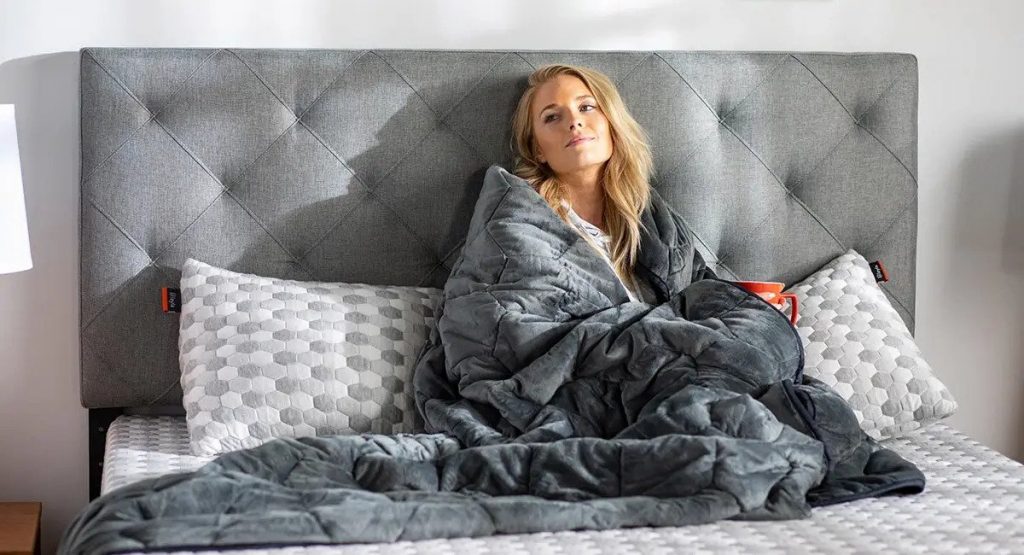
2. Luxome Removable Cover Weighted Blanket
This blanket is 100% Percale Cotton inner weighted and comes with a removable cover and Oxford carrying tote. It’s available in Small – 8lbs (42” × 56”), Medium – 15lbs (54” × 72”), Large – 18lbs (60” × 80”), and XL – 30lbs (100” × 85”).
Why is it on our list?
- Certified lead-free 1mm glass beads
- Doesn’t overheat
- No weight bunching, perfect weight per square foot
- Certified STANDARD 100 by OEKO-TEX
- Machine washable blanket and cover
- Available in Minky and bamboo lyocell
- Bamboo lyocell feels soft, cool, and silky, regulates heat, wicks moisture, and is eco-friendly
- The Minky variant feels soft, velvety, plush, similar to fleece/microfiber, is warmer, and retains heat
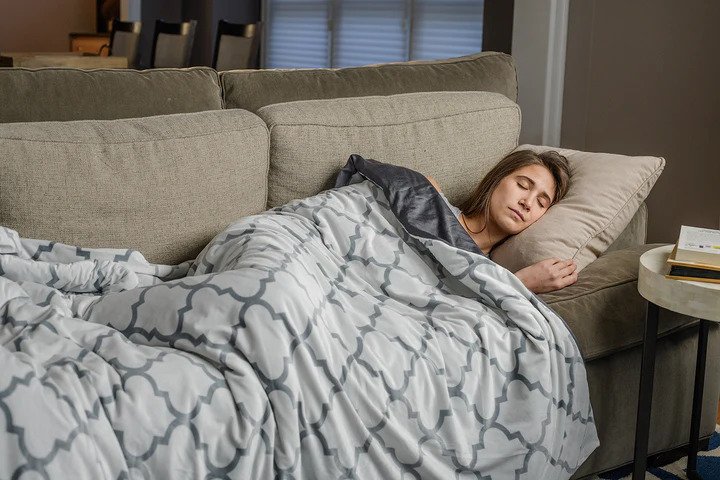
3. Moonbow The All-Season Weighted Blanket
This all-season blanket comes in 2 color options for duvet covers and is available in 15 and 20lbs variants.
Why is it on our list?
- It has a bamboo fiber side for a cooling sensation on hot summer nights
- The other side is polyester for cooler fall nights
- The micro-plush duvet cover works to warm the chilly winter nights
- 30-day return policy
- Pay in 4 interest-free payments
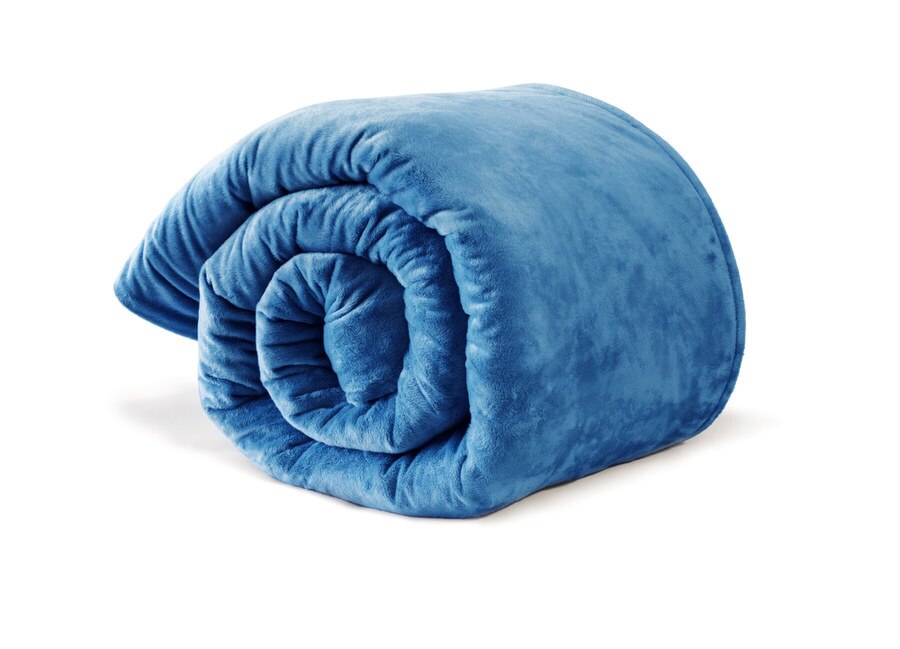
4. Muslin Comfort The 365 Blanket
This temperature-regulating blanket is available in 11 colors and 4 sizes: oversized twin (96” × 71”), oversized full (96” × 96”), oversized queen (110” × 110”), and oversized/California king (120” × 120”).
Why is it on our list?
- Temperature regulating and breathable weaving – best blankets for sleeping in warm temperatures
- All blankets have an ideal weight with a king size being 8lbs only
- Made of hypoallergenic 100% cotton
- Machine washable and dryable
- With every wash, it won’t shrink but gets softer
- 30-night risk-free trial and free returns
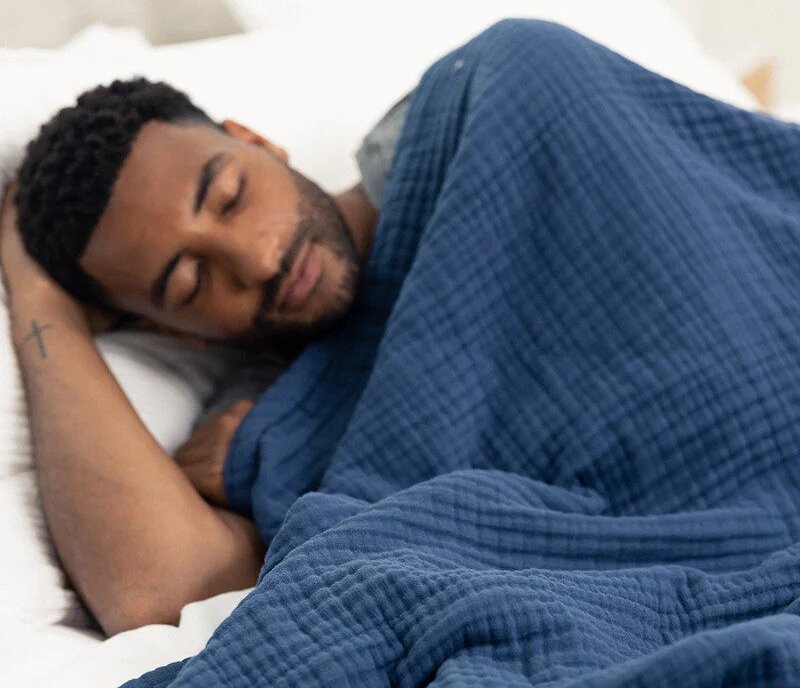
5. Mosaic Minky Weighted Blanket
These blankets are available in 3 weights (5, 8, and 10lbs), 4 sizes (kids – 38” × 50”, throw – 38” × 60”, twin 42” × 72 “, and full 54” × 75”), and 9 colors.
Why is it on our list?
- 100% new, BPA-free, hypoallergenic plastic pellets used – FDA certified
- No glass or sand pellets
- Handmade and evenly-weighted
- Machine washable
- 30-day money-back guarantee
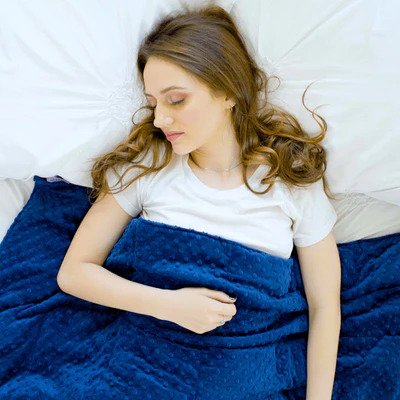
Wondering when you’ll part with your blanket? The answer is right here…
When should you replace a blanket?
A blanket can last you anywhere between 8-15 years minimum. However, if you notice changes like wear and tear, decolorization, a permanent odor, pilling, allergic reactions, lumping, or any warming or overheating issues even before the mentioned lifetime, replace it ASAP.
Final Statement
Follow this guide throughout and you won’t regret the treasure (your blanket, of course!) you find in the end.
But remember that investing in a good blanket isn’t the end of your responsibility. You must be equally committed even after buying it.
If you take care of the blanket and follow the label care label, your blanket will love you back as much.
And when you visit the store, don’t feel shy to discuss your needs with your shopping executive. Since products from every brand vary, a consultation won’t be a bad idea!

